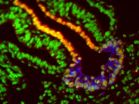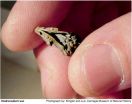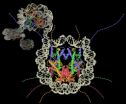(Press-News.org) A rose by any other name would smell as sweet; the saying is perhaps a testament to the acute sense of smell that is unique to mammals. Paleontologists have now discovered that an improved sense of smell jumpstarted brain evolution in the ancestral cousins of present-day mammals. The research will appear in the 20 May 2011 issue of the journal Science, which is published by AAAS, the international, nonprofit science society.
The findings may help explain why mammals evolved such large and complex brains, which in some cases ballooned 10 times larger than relative body size. By reconstructing fossils of two Early Jurassic Period mammals--Morganuocodon and Hadrocodium--the authors provide new evidence that the mammalian brain evolved in three major stages: first by improvements in sense of smell or olfaction; next by an increase in touch or tactile sensitivity from body hair; and third by improved neuromuscular coordination or the ability to produce skilled muscle movement using the senses.
"Now we have a much better idea of the historical sequence of events and of the relative importance of the different sensory systems in the early evolution of mammals. It paints a much more vivid picture of what the ancestral mammal was like and how it behaved, and of our own ancestry," said lead author Tim Rowe, Director of the Vertebrate Paleontology Laboratory at the University of Texas at Austin.
The study used a medical imaging technique called X-ray computed tomography or CT to reconstruct brain molds or endocasts of the 190 million year old Morganuocodon and Hadrocodium fossils from China. These tiny, shrew-like critters are thought to be precursors to existing mammals or "pre-mammals. A brain endocast is a mold of the space or cavity that encases in the brain. The brain endocasts used in this study occurred naturally through fossilization.
CT technology is indispensible for analyzing fragile fossils because it allows researchers to create precise, three-dimensional images of a fossilized brain cavity without having to destroy the fossil in order to expose the endocast.
Rowe's team spent several years CT scanning over a dozen pre-mammal brain endocasts at the High-Resolution X-ray Computed Tomography Facility at The University of Texas at Austin. The scans are archived online and freely available on www.digimorph.org.
The three-dimensional images gave the researchers a magnified, inside view of the brain and nasal cavities of the fossils. The team observed that the nasal cavity and related smell regions were enlarged in the pre-mammal fossils, along with areas of the brain that process olfactory information. Both characteristics indicate an improved sense of smell in pre-mammals.
The study also looked at the influence of body hair development on brain size. For example, the paper clip-sized Hadrocodium sported fur, and evidence from fossilized pelts or skin of closely related animals hints that Morganuocodon likely had hair too. The authors speculate that hairy early mammals were quick to develop a keen sense of touch or tactile sensitivity, along with enhanced motor coordination.
Rather than being used for warmth, body hairs initially served as tiny air traffic controllers, allowing pre-mammals to navigate small crevices and avoid harm. This heightened tactile sensitivity eventually lead to the formation of intricate sensory fields in the neocortex of mammalian brain, the authors propose.
Since the necortex is involved in tasks like sensory perception and the generation of motor commands, improvements in its function likely lead to the fine-tuning of early mammals' motor skills and neuromuscular coordination. In both fossils, the size of the cerebellum (the region of the brain responsible for sensory-motor integration) grew so large it began to ripple over into folds; this increase in size supports the idea that early mammals developed advanced neuromuscular coordination.
Comparing the mammal brain endocasts with fossils of other groups, like those of primitive reptiles called cynodonts, revealed that the brains of the Morganucodon and the Hadrocodium were almost 50 percent larger than the brains of mammal precursors. Taken together, the results hint that the ability to exploit a world of information dominated by odors and smells made early mammals extraordinarily different from even their closest extinct relatives.
"Now that we have a general picture of the brain in mammals ancestrally, we plan to explore the subsequent diversification of the brain and sensory systems as mammals evolved and diversified. This will unlock new secrets about how huge brains and extreme sensory adaptations evolved in mammals, such as electroreception in the platypus, and sonar in whales and bats. It is all very exciting!" Rowe said.
###
This research was funded by the National Science Foundation, the University Of Texas Jackson School Of Geosciences, and the National Natural Science Foundation of China.
The American Association for the Advancement of Science (AAAS) is the world’s largest general scientific society, and publisher of the journal, Science (www.sciencemag.org) as well as Science Translational Medicine (www.sciencetranslationalmedicine.org) and Science Signaling (www.sciencesignaling.org). AAAS was founded in 1848, and includes some 262 affiliated societies and academies of science, serving 10 million individuals. Science has the largest paid circulation of any peer-reviewed general science journal in the world, with an estimated total readership of 1 million. The non-profit AAAS (www.aaas.org) is open to all and fulfills its mission to “advance science and serve society” through initiatives in science policy; international programs; science education; and more. For the latest research news, log onto EurekAlert!, www.eurekalert.org, the premier science-news Web site, a service of AAAS. END
Sniff sniff: Smelling led to smarter mammals, researchers say
Fossil study describes 3 key evolutionary steps toward large and complex brains
2011-05-20
ELSE PRESS RELEASES FROM THIS DATE:
Mammals first evolved big brains for better sense of smell
2011-05-20
Mammals first evolved their characteristic large brains to enable a stronger sense of smell, according to a new study published this week in the journal Science by paleontologists from The University of Texas at Austin, Carnegie Museum of Natural History and St. Mary's University in San Antonio.
This latest study is the first to use CT technology, similar to medical scanners, to reconstruct the brains of two of the earliest known mammal species, both from the Jurassic fossil beds of China. The 3D scans revealed that even these tiny, 190-million-year-old animals had developed ...
Predicting the fate of personalized cells next step toward new therapies
2011-05-20
PHILADELPHIA – Discovering the step-by-step details of the path embryonic cells take to develop into their final tissue type is the clinical goal of many stem cell biologists.
To that end, Kenneth S. Zaret, PhD, professor of Cell and Developmental Biology at the Perelman School of Medicine at the University of Pennsylvania, and associate director of the Penn Institute for Regenerative Medicine, and Cheng-Ran Xu, PhD, a postdoctoral researcher in the Zaret laboratory, looked at immature cells called progenitors and found a way to potentially predict their fate. They base ...
Large brains in mammals first evolved for better sense of smell
2011-05-20
Pittsburgh, Pennsylvania… Paleontologists have often wondered why mammals—including humans—evolved to have larger brains than other animals. A team of paleontologists now believe that large brains may have developed in mammals to facilitate an acute sense of smell, according to a new paper published today in the prestigious journal Science. The team also noticed enlargement in the areas of the brain that correspond to the ability to sense touch through fur; this sense is acutely developed in mammals.
Scientists used high-resolution CT scans to study rare 190-million-year-old ...
Death of Osama bin Laden Highlights Importance of the Zadroga Act, Says New York Personal Injury Lawyer
2011-05-20
After the death of Osama bin Laden, New York personal injury lawyer David Perecman reaffirmed his commitment to help the heroes who are still battling illnesses connected to 9/11.
For many individuals, the death of bin Laden brought closure. The death also served to rekindle memories of those who volunteered to assist at the World Trade Center site after the 9/11 attacks.
The lives of many Ground Zero volunteers were changed in challenging ways. Rescue and recovery workers and others are still suffering from health consequences related to the World Trade Center disaster.
"People ...
Scientists discover new drug target for squamous cell carcinoma
2011-05-20
SEATTLE – Researchers at Fred Hutchinson Cancer Research Center have discovered a new drug target for squamous cell carcinoma – the second most common form of skin cancer. Scientists in the laboratory of Valeri Vasioukhin, Ph.D., have found that a protein called alpha-catenin acts as a tumor suppressor and they also have unlocked the mechanism by which this protein controls cell proliferation.
The findings by Vasioukhin and colleagues will be published May 24 in Science Signaling.
For the study, the researchers studied mice that were bred to lack a copy of the gene that ...
Packaging process for genes discovered in new research
2011-05-20
Scientists at Penn State University have achieved a major milestone in the attempt to assemble, in a test tube, entire chromosomes from their component parts. The achievement reveals the process a cell uses to package the basic building blocks of an organism's entire genetic code -- its genome. The evidence provided by early research with the new procedure overturns three previous theories of the genome-packaging process and opens the door to a new era of genome-wide biochemistry research. A paper describing the team's achievement will be published in the journal Science ...
Senators Want DUI Applications Removed From Smartphones
2011-05-20
In March, four Democratic U.S. Senators, Harry Reid, D-Utah, Chuck Schumer, D-N.Y., Frank Lautenberg, D-N.J., and Tom Udall, D-N.M., drafted a letter requesting that Apple, Google and Research in Motion (or RIM) eliminate the applications (user-friendly computer programs for specific tasks) on mobile communication devices that warn drivers of the locations of drunk-driving checkpoints.
The next day, RIM, the manufacturer of the BlackBerry agreed to the removal of driving-under-the-influence (DUI/DWI) checkpoint functionality on its BlackBerry devices.
Google later ...
What Causes the Metal Skin on an Airliner to Tear Apart?
2011-05-20
On Friday, April 1, 2011, a Southwest Airlines Boeing 737-300 experienced a rapid decompression when the metal fuselage skin tore apart, leaving a 5X1 foot hole. This kind of event is rare, but can, and has been, catastrophic when it does occur.
In 1988, another Boeing 737, a 200 model, experienced a similar, but much worse, event over Hawaii. In that case, the skin on the entire front section of the aircraft cabin was denuded, leaving the passengers sitting in the first several rows completely exposed, with the aircraft being held together by two metal spars running ...
Of frogs, chickens and people
2011-05-20
Researchers at the University of California, San Diego School of Medicine have uncovered new details of an unusual biological mechanism in the brains of diverse species that not only helps regulate how their brains develop, but also how they function later in life. The discovery could lead to new biomarkers for specific neurological diseases in humans and, possibly, the development of drugs to cure them.
The research, by Miles F. Wilkinson, PhD, professor of reproductive medicine and a member of the UCSD Institute for Genomic Medicine, and colleagues, is published in ...
Preparing for a Prenuptial Agreement
2011-05-20
Thinking about, let alone preparing for, divorce before you are even married is not what most of us want to do. Whether we believe that divorce will never happen to us or whether we just choose to ignore the possibility, the fact remains that almost half of all marriages in the United States end in divorce.
One way to enter into a marriage prepared for all outcomes is to create a prenuptial agreement. Creating this agreement doesn't mean that your marriage will eventually come to an end. Rather, creating a prenuptial agreement is just a way for you and your spouse to ...
LAST 30 PRESS RELEASES:
GeoFlame VISION: Using AI and satellite imagery to predict future wildfire risk
Nationwide study suggests that water treatment methods may impact the risk of legionnaires’ disease
Oyster larvae on drugs move slowly and are stressed
Targeting a specific brain circuit may help prevent opioid relapse, WSU study finds
Tec-Dara combination offers substantial improvement over standard second-line therapies for relapsed or refractory multiple myeloma
Improving treatment for an autoimmune bleeding condition
Drug reduced need for blood transfusions during hospitalization for non-cardiac surgery
Novel agent ianalumab added to standard therapy extends time to treatment failure in patients with previously treated immune thrombocytopenia
Pirtobrutinib outperforms bendamustine plus rituximab for previously untreated CLL/SLL
Online tracking and privacy on hospital websites
A freely available tool to document wartime destruction
Residential solar panels can raise electricity rates
Scientists use synthetic platelets as ‘Trojan horse’ drug-delivery system
Cooperative Intermolecular Interactions Regulate Supramolecular Polymer Assembly
Korea University researchers develop ultrasensitive method to detect low-frequency cancer mutations
First patient enrolled in GOG-3133/ FRAmework-01 phase 3 study evaluating sofetabart mipitecan (LY4170156), a novel ADC targeting folate receptor alpha (FRα), in recurrent ovarian cancer
Two Hebrew University researchers win prestigious ERC consolidator grants
ERC grant helps to quantify the impact of anthropogenic air pollution particles on climate
Exercise might help improve mobility during aging
New online tool detects drug exposure directly from patient samples
Learn the surprising culprit limiting the abundance of Earth’s largest land animals
Study reveals new ways the brain regulates communication between neurons
Research reveals new hybrid state of matter where solids meet liquids
Researchers develop a new computational tool to understand how genetic interactions impact human traits
Elephants, giraffes and rhinos go where the salt is
Cancer loses its sense of time to avoid stress responses
The twisted nanotubes that tell a story
Flaring black hole whips up ultra-fast winds
Study explores the link between newspaper preference and attitudes towards autism
Artificial turf in the Nordic climate – a question of sustainability
[Press-News.org] Sniff sniff: Smelling led to smarter mammals, researchers sayFossil study describes 3 key evolutionary steps toward large and complex brains



